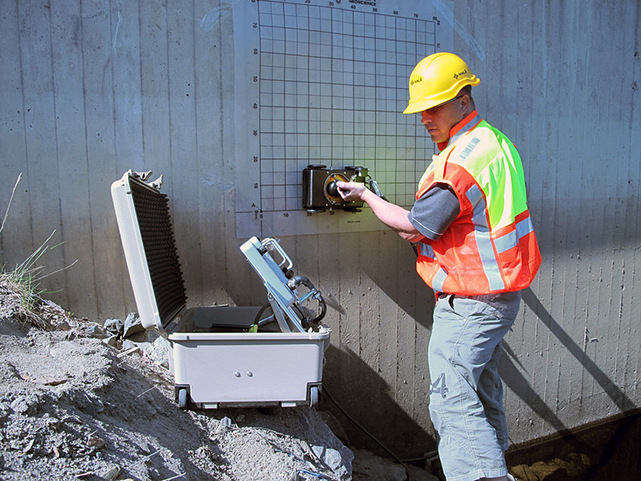The Importance of Specialist Concrete Scanning Solutions
The Importance of Specialist Concrete Scanning Solutions
Blog Article
Past the Surface Area: Leveraging Advanced Concrete Scanning Techniques for Unmatched Precision and Insight
In the world of building and infrastructure maintenance, the quest for precision and thoroughness is incessant. Advanced concrete scanning strategies have become important tools in this pursuit, using a glimpse below the surface to introduce a world of important understandings. By harnessing sophisticated innovations, experts can uncover abnormalities, examine the condition of concrete frameworks, and make notified choices that shape the course of jobs. The effects of these techniques extend much past plain surface-level analyses, guaranteeing a depth of precision and understanding that is unrivaled.
Importance of Advanced Concrete Scanning
The relevance of making use of sophisticated concrete scanning techniques hinges on the unequaled accuracy they provide for spotting sub-surface anomalies and ensuring structural integrity. By employing cutting-edge innovations such as ground-penetrating radar (GPR), electromagnetic induction, and progressed finder imaging, building and construction specialists can dig beneath the surface area of concrete structures with a degree of accuracy that much exceeds typical evaluation techniques. Concrete Scanning. These strategies allow the identification of covert hazards like rebar deterioration, gaps, channels, or post-tension wires that might jeopardize the stability and safety of a structure over time
Additionally, progressed concrete scanning supplies invaluable understandings right into the overall problem of a concrete component without the requirement for intrusive steps, decreasing the danger of creating damages during the assessment process. The capability to determine the specific area and deepness of possible concerns enables targeted repairs and upkeep, eventually extending the life-span of the structure and optimizing its performance. Basically, the value of innovative concrete scanning can not be overstated in the world of building and construction and facilities upkeep, where accuracy and integrity are vital.
Kinds of Cutting-Edge Technologies

Anomalies and Issue Detection

Along with GPR, concrete scanning strategies like thermography and impact-echo screening are likewise efficient in discovering abnormalities and defects. Thermography uses infrared modern technology to determine variations in surface temperature level, showing possible areas of concern such as delamination or dampness ingress. On the other hand, impact-echo screening involves evaluating acoustic reactions to find voids, splits, and other issues within the concrete. By leveraging these innovative strategies, professionals can proactively deal with structural concerns, making sure the longevity and security of concrete structures.
Assessing Concrete Problem
Just how can engineers accurately assess the condition of concrete frameworks to ensure their longevity and security? Analyzing the concrete condition is an important element of preserving infrastructure integrity. Numerous sophisticated concrete scanning methods are employed for this objective. Ground-penetrating radar (GPR) is commonly made use of to evaluate the interior structure of concrete, spotting gaps, cracks, and other abnormalities that may jeopardize its toughness. Additionally, impact-echo testing can supply insights into the thickness and honesty of concrete aspects. Ultrasonic pulse rate testing is another beneficial method for evaluating Extra resources concrete top quality by determining the speed of acoustic waves through the material.
Additionally, aesthetic examination continues to be a basic part of concrete problem assessment. Designers aesthetically examine the surface area for signs of damage, such as spalling, breaking, or staining. Integrating non-destructive testing approaches with visual evaluations enables a detailed analysis of concrete problem, enabling engineers to recognize potential problems beforehand and implement timely maintenance or repair work. By leveraging these advanced techniques, designers can make certain the long-term durability and safety and security of concrete frameworks.
Enhancing Decision-Making Procedures
In the world of infrastructure management, enhancing decision-making processes is imperative for making sure the effective upkeep and durability of concrete structures. Improved decision-making procedures in concrete administration entail making use of sophisticated scanning methods to collect detailed information on the problem of structures. By leveraging innovations such as ground-penetrating radar and 3D imaging, stakeholders can make informed decisions pertaining to repair work, substitute, or reinforcement techniques.
These progressed scanning techniques offer very useful insights right into the internal structure of concrete, determining prospective issues such as gaps, cracks, or rust that may not be noticeable externally. This degree of thorough information enables for positive upkeep planning, lessening the threat of structural failures and raising the overall life expectancy of concrete structures.
Furthermore, by including digital documentation and evaluation devices right into the decision-making process, stakeholders can track the advancement of concrete conditions in time, enabling predictive upkeep strategies and optimizing source allowance. Eventually, the assimilation of sophisticated concrete scanning methods enhances decision-making processes by offering unrivaled accuracy, understanding, and effectiveness in infrastructure management.
Verdict
Finally, advanced concrete scanning strategies provide unmatched accuracy and understanding in detecting anomalies, flaws, and analyzing the site link problem of concrete frameworks. By leveraging advanced modern technologies, decision-making processes can be enhanced, bring about even more educated and efficient solutions for maintaining and fixing concrete infrastructure. These strategies play an essential duty in making certain the safety and security and long life of concrete frameworks, making them a crucial tool in the field of building and design.
Additionally, advanced concrete scanning supplies very useful understandings right into the overall problem of a concrete component without the need for invasive steps, lessening the threat of causing damages throughout the evaluation procedure - Concrete Scanning. One more cutting-edge technology is 3D X-ray scanning, which offers comprehensive images of the internal framework of concrete, supplying beneficial pop over to this site info without the requirement for devastating testing. Additionally, Concrete Cover Meters are used to gauge the density of concrete cover over reinforcement bars properly. Improved decision-making procedures in concrete administration entail using innovative scanning strategies to collect detailed data on the condition of structures.In conclusion, progressed concrete scanning methods use unrivaled accuracy and insight in identifying anomalies, issues, and assessing the condition of concrete structures
Report this page